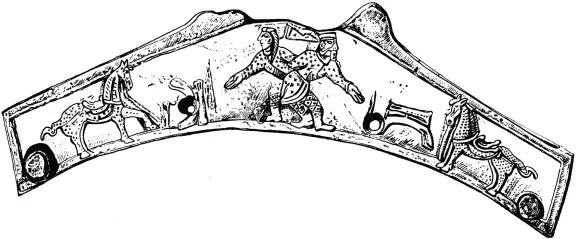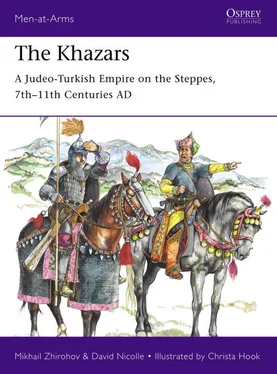According to al-Mas’udi, the Khazar Khagans recruited around 7,000 mounted and armoured archers and spearmen from Muslim communities around the capital city, Atil, or from neighbouring Islamic lands, or perhaps from both. These formed the Arsiya (al-Arsiya), sometimes described by modern historians as Muslim mercenaries or a ‘Khwarazmian guard’. In fact the contemporary sources do not call them mercenaries (in the usual sense of temporary hirelings), and they appear to have lived or been settled permanently around Atil. Nevertheless, most do appear to have been of Khwarazmian origin; al-Mas’udi maintains that their movement from Khwarazm, south of the Aral Sea, to the Volga Delta area was a result of hunger and plague. When this occurred is unknown, but it was no earlier than the end of the 8th century, by which time Khwarazm had been thoroughly Islamized. The supposedly ‘heavy equipment’ of such Arsiya may also have been no heavier than that of the best-equipped Khazar elite, but the Arsiya’s combat effectiveness was undeniable.

Decoration on the rim of a Khazar silver dish showing men and horses; note that the saddles are shown without stirrups. (Archive of M Zhirohov)
Some Arab descriptions of the Khazar army refer to the Burtas from the north supposedly supplying the Khagan with 10,000 horsemen, but, in apparent contradiction, others state that the Burtas were so poor that ‘only the one who possesses great wealth owns a horse’. Furthermore, they were said to lack any armour. In fact archaeological evidence shows the Burtas to have been armed either with sabres like those of the partially Khazar Saltov-Mayaki culture between the Don and Dneiper rivers, or with straight swords, plus bows, axes, fighting knives, spears and javelins. The actual number of Burtas warriors remains unclear, but if this term encompassed all the Mordvin tribes (speaking a Finnish tongue), then figures given in Arab sources could be plausible.
The suggested number of 20,000 for allied or vassal troops from the Volga Bulgars appears more realistic, but when the same figure is given for the Magyars it is probably exaggerated. Like the Magyars, the Volga Bulgars had tried to escape Khazar domination in the early 10th century but, as Ibn Fadlan noted, they still had to obey the Khagan’s often unwelcome orders. By the mid-10th century, however, these Volga Bulgars had achieved almost complete independence. Detachments of Eastern Slavs similarly served the Khazar Khaganate as auxiliary infantry, but there is no reliable information about their numbers. Judging by finds of horse harness in the archaeological record, a minority of them probably fought as light cavalry.
Discipline was ferocious in the Khazar army, according to Ibn Fadlan (who was, of course, probably repeating what he had been told by the Khazars’ neighbours and rivals):
No squadron [the Khagan] dispatches will turn back or retreat, no matter what happens. Those who come back after a defeat are killed. If his generals and the deputy are defeated, he has them brought into his presence, along with their women and childen, and gives the women and children to another man before their very eyes. He does the same with their horses, belongings, weapons, and residences. Sometimes he cuts them in two and gibbets them. Sometimes he hangs them by the neck from a tree. Sometimes he makes them into stable-hands◦– if he means to be kind to them, that is. [1] Ibn Fadlan, quoted by Yaqut (trans J. E. Montgomery), Mission to the Volga (New York, 2017) 52–53
To summarize, in its heyday the Khazar Khaganate could call upon armed forces numbering 80,000 to 100,000 people. Given the extent of Khazar territory at its zenith, and the size of its population including subordinate peoples, such a figure appears entirely realistic.
The armed forces of the Khazar Khaganate had a rich array of military equipment, including various types of helmet and armour, shields, and distance weapons such as bows. Close-combat weapons ranged from slightly curved single-edged sabres and straight double-edged swords, to daggers, spears, axes and war-flails. By c. AD 750 the Khazars already made use of a broader array of military gear than any other people in Eastern Europe.
Archaeological evidence also shows that there were variations in the styles used in different regions of the Khaganate. The most complete array is found in specifically Khazar burials, and includes mail and lamellar armour, helmet, sabre, large fighting knife or khanjar, smaller knife, war-flail, axe, spear and bow. This was clearly the equipment of a mounted warrior, and it was almost invariably associated with items of horse harness.
On the western fringes of the Khaganate the Khazar army included significant Alan contingents, and up to three-quarters of their warrior burials contained axes, fighting knives and infantry bows; Alan cavalry rarely had armour, but were now armed with bow, sabre, fighting knife, axe and war-flail. The military equipment of Magyar and Bulgar soldiers was very similar to that of the Khazars during the 8th to 10th centuries, with bow, sabre, fighting knife, spear, axe and mace. There are no finds of identifiably Bulgar or Magyar armour from the steppes during this period, but Khazar helmets are known (and it is, of course, likely that any armour was normally too valuable to be deposited in the graves of any but the wealthiest warriors).
Little is known about Eastern Slav military equipment, but it may have had features in common with that of the Northern Slavs. Examples of their war gear from Bititsa (Sumy region of northern Ukraine) included a sabre with a distinctive hilt, a war-flail, mace, wooden shield with a large boss or (less likely) a small round shield, battle-axes, arrowheads, spears, and a remarkable number of javelins.
Bows and arrows
The normal scenario for an early-medieval battle between steppe nomads began with a shoot-out between archers, followed by a mêlée, and then the pursuit and slaughter of the vanquished. The side that was unable to endure the initial arrow-shower was immediately upon the defensive, and almost always lost.

Khazar arrowheads, illustrating the wide range of shapes; the extremes are the slimmest armour-piercing points (16–19), and ‘chisel’ heads for causing maximum injury and blood-loss to unarmoured men and animals (20 and 23–26).
(1 & 18) from Lysiy Gorb; (2, 4, 5, 10, 11, 20, 23 & 25) from Chir-Yurt; (3,12, 14, 19 & 24) from Kochetok; (6 & 8) from Portovoye; (7) from Sukhaya Gomolsha; (9, 13, 16 & 17) from Krasnaya Gorka; (15 & 26) from Novaya Pokrovka; (21 & 22) from Syvashovka. (Drawings by A. Karbivnychyi after V. Kriganov)
Khazars bows were of complex construction, in the usual Central Asian form which had appeared at the start of the first millenium AD with the arrival of the Xiongnu (whom some scholars believe were ancestors of the Huns). The core of such a bow was made of various types of wood, strengthened by plates of bone attached to the outside. Examples preserved in burials show that the bone elements of the Khazar bow included lateral and frontal pieces, plus others on the ‘ears’ (tips) and the ‘belly’ (centre). The lateral plates were almost always paired, while the ears were in the form of elongated tapering plates with a notch for the bowstring. Bows from the 7th and 8th centuries were of the same design, but during the 8th century the shape of the ends of the lateral overlays changed slightly, becoming more elongated with the bowstring notch now off-centre; meanwhile, the central plates became almost leaf-shaped.
Читать дальше














